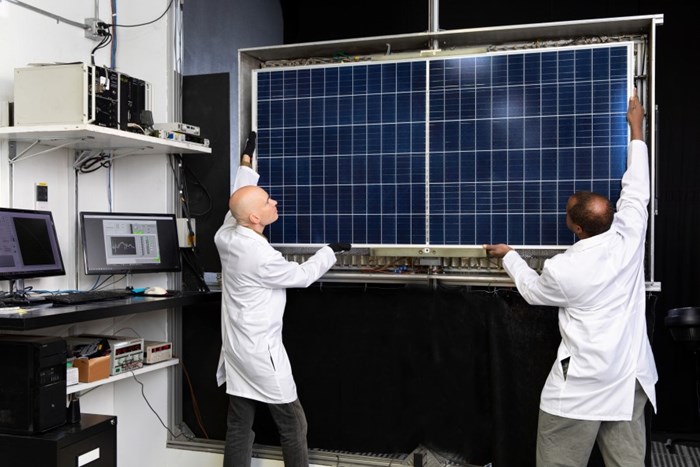How PVEL’s ‘PV Module Reliability Scorecard’ is powering the energy transition
On a mission to accelerate the adoption of solar tech
Global power generation from solar photovoltaic (PV) is growing rapidly, but not rapidly enough, says the International Energy Agency (IEA). Kiwa Group member PVEL, short for PV Evolution Labs, has made it its mission ‘to support the worldwide PV buyer community by generating data that accelerates adoption of solar technology’. The recently published 2023 PV Module Reliability Scorecard is one more example of how PVEL is delivering on that mission.

Global power generation from solar photovoltaic (PV) increased by a record 179 TWh (up 22%) in 2021 to exceed 1 000 TWh, according to IEA data. After wind, that makes solar PV the fastest grower in renewable energies. But it’s not enough: the IEA states that we will need an average annual generation growth of 25% between 2022 and 2030 to achieve the much-discussed ‘Net Zero Emissions by 2050’ scenario. “Our increasing dependence on solar energy will generate more innovative technologies and products with more manufacturers and downstream projects which, in turn, will propel investment in the coming years. This is exactly where our company and our Scorecard can make a difference,” says Tristan Erion-Lorico, VP of Sales and Marketing at PVEL.
Connecting manufacturers and buyers
A member of the Kiwa Group since 2021, with headquarters in California, USA, PVEL is the world’s leading reliability and performance testing lab for PV modules. Its flagship Product Qualification Program (PQP) centres on carrying out tests for power degradation, safety, and durability. The durability tests cover everything from functional testing to the ability to withstand climatic conditions and longevity, which is tested for 25- to 30-year terms. All the data the company collects is made publicly available in the PVEL Scorecard, the latest edition of which was released on May 23rd. “Our bankability testing and data-driven reports connect manufacturers with a global network of PV equipment buyers and investors,” explains Tristan.
The whole Bill of Materials
The testing, for which companies can apply voluntarily, initially involves a third party inspection of the manufacturing site to verify the components. Once verified, the components are shipped to the PVEL lab, either in the US or China, for intensive testing for the whole Bill of Materials (BOM). To date, PVEL has tested over 500 BOMs from more than 60 manufacturers. BOMs include frames, glass, cells, backsheets, encapsulants and junction boxes. The PVEL team conducts visual tests to ensure there are no observable defects in the samples, as well tests such as Thermal Cycling. “For companies that want to be certified, labs perform the Thermal Cycling test 200 times at temperatures ranging from minus 40 to plus 85 degrees Celsius,” explains Tristan. “To qualify for certification, the maximum acceptable loss of power during the test must be no more than 5%. At PVEL the test is repeated 600 times in the same climatic conditions -and companies who aim to qualify for a Top Performer place in our Scorecard, power loss cannot exceed 2%. It’s a far more rigorous benchmark.”
This year's Top Performers
The PV Module Reliability Scorecard is issued each year by PVEL, it showcases manufacturers that produce PV modules with noteworthy results in its independent testing. The PQP test plan is updated every two years, as new research and new technologies develop. This year the PV modules tested were manufactured in 12 different countries, says Tristan. “The 2023 Scorecard, our 9th edition, names 250 model types of PV modules from 35 manufacturers as Top Performers in PVEL’s testing, the most in our company’s history.”
PVEL presented awards to the Top Performers at the 16th International Photovoltaic Power Generation and Smart Energy Conference & Exhibition in Shanghai (SNEC) - which reportedly attracted over half a million visitors from around the world.

Quality and numbers are going up
According to Tristan, the record number is not a random peak: “Our Scorecards are showing an increasing number of Top Performer manufacturers and models, suggesting an overall improvement in quality.” Having said that, the percentage of manufacturers that experienced a failure also increased: almost a third of the BOMs tested suffered at least one failure during testing, and 15% of BOMs had a failure before stress testing.
This year’s Scorecard also includes case studies from the factory and the field, showing how real-world performance is addressed through reliability testing. “The 9th edition was a labour of love”, quips Tristan, adding that it was created with the help of numerous other Kiwa partners, including PI Berlin and Extel Energy, was released online on May 23rd.
An easy way to the best solutions
For PVEL and its growing range of customers, the value and significance of the PVEL Scorecard is evident. Explains Tristan, “Solar technology and the manufacturing landscape continue to evolve rapidly. With module supply issues persisting, buyers need guidance on how to procure the best possible modules for their projects. Our 2023 Scorecard, for example, features a truly global list of module manufacturers. For buyers worldwide looking to understand the critical differences across cell technologies and module designs, it provides many key insights. Whether you’re a veteran o a newcomer, it’s an easy way to search through the best commercially available options or developers.”
Check the 2023 Scorecard now
The Scorecard is available online (PVEL Scorecard #9) and includes a searchable and exportable database. Top Performers can be filtered by PQP test, cell technology, factory location, power class and more. You can download and export search results directly from the site.




